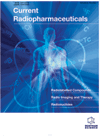- Home
- A-Z Publications
- Current Radiopharmaceuticals
- Previous Issues
- Volume 14, Issue 1, 2021
Current Radiopharmaceuticals - Volume 14, Issue 1, 2021
Volume 14, Issue 1, 2021
-
-
Experimental Breast Cancer Models: Preclinical Imaging Perspective
More LessAuthors: Ulku Korkmaz and Funda UstunBackground: Breast cancer is the leading cause of cancer in women. 13% of breast cancer patients are at a distant stage and mortality is due to metastases rather than primary disease. The unique genetic structure and natural process of breast cancer make it a very suitable area for targeted therapies. Experimental tumor models are validated methods to examine the pathogenesis of cancer, the onset of the neoplas Read More
-
-
-
Animal Models for the Evaluation of Theranostic Radiopharmaceuticals
More LessAuthors: Selin Soyluoglu and Gulay Durmus-AltunBackground: Theranostic is a new field of medicine that combines diagnosis and patient- specific targeted treatment. In the theranostic approach, it is aimed to detect diseased cells by using targeted molecules using disease-specific biological pathways and then destroy them by cellular irradiation without damaging other tissues. Diagnostic tests guide the use of specific therapeutic agents by demonstrating the presence Read More
-
-
-
Thymoquinone Glucuronide Conjugated Magnetic Nanoparticle for Bimodal Imaging and Treatment of Cancer as a Novel Theranostic Platform
More LessBackground: Theranostic oncology combines therapy and diagnosis and is a new field of medicine that specifically targets the disease by using targeted molecules to destroy the cancerous cells without damaging the surrounding healthy tissues. Objective: We aimed to develop a tool that exploits enzymatic TQ release from glucuronide (G) for the imaging and treatment of lung cancer. We added magnetic nanoparticles (M Read More
-
-
-
Polymer Coated Iron Nanoparticles: Radiolabeling & In vitro Studies
More LessAuthors: Selin Yilmaz, Cigdem Ichedef, Kadriye Buşra Karatay and Serap TeksözBackground: Superparamagnetic iron oxide nanoparticles (SPIONs) have been extensively used for targeted drug delivery systems due to their unique magnetic properties. Objective: In this study, it has been aimed to develop a novel targeted 99mTc radiolabeled polymeric drug delivery system for Gemcitabine (GEM). Methods: Gemcitabine, an anticancer agent, was encapsulated into polymer nanoparticles (PLGA) togeth Read More
-
-
-
Radioiodination of Pimonidazole as a Novel Theranostic Hypoxia Probe
More LessBackground: Tumors are defined as abnormal tissue masses, and one of the most important factors leading to the growth of these abnormal tissue masses is Vascular Endothelial Growth Factor, which stimulates angiogenesis by releasing cells under hypoxic conditions. Hypoxia has a vital role in cancer therapy, thus it is important to monitor hypoxia. The hypoxia marker Pimonidazole (PIM) is a candidate biomarker of cancer aggr Read More
-
-
-
Physiological Animal Imaging with 68Ga-Citrate
More LessAuthors: Ayşe Uğur and Aziz GültekinBackground: Gallium-68 is an ideal research and hospital-based PET radioisotope. The uptake mechanism of Gallium citrate is a combination of specific and non-specific processes, for example, vasodilatation, increased vascular permeability, plasma transferrin binding and lactoferrin and siderophores. Objective: In this study, by applying the 68Ge/68Ga generator product, a simple technique for the synthesis and quality co Read More
-
-
-
Extremity Exposure with 99mTc - Labelled Radiopharmaceuticals in Diagnostic Nuclear Medicine
More LessAuthors: Mpumelelo Nyathi, Thabiso M. Moeng and Doctor Paul A MaboeBackground: Extremity exposures may raise the risk of cancer induction among radiographers involved in the preparation and administration of technetium-99m labelled radiopharmaceuticals. Objective: To estimate finger doses on radiographers at a South African tertiary hospital. Methods: Adhesive tape was used to securely fix a calibrated thermoluminescent dosimeter (TLD) on fingertips and bases of ring and index finger Read More
-
-
-
Diagnostic Value of the Early Heart-to-Mediastinum Count Ratio in Cardiac 123I-mIBG Imaging for Parkinson's Disease
More LessBackground: Early diagnosis of Parkinson's disease (PD) is of primary importance. The delayed (3-4 h after injection) Iodine-123-Metaiodobenzylguanidine (123I-mIBG) scintigraphy has been proven to be effective in early differential diagnosis for Lewy body disease. But early imaging (15-30 min after injection) has only been marginally studied for its possible diagnostic role. In this prospective study, a threshold Read More
-
-
-
Impact of Tracer Retention Levels on Visual Analysis of Cerebral [18F]- Florbetaben Pet Images
More LessBackground: To compare visual and semi-quantitative analysis of brain [18F]Florbetaben PET images in Mild Cognitive Impairment (MCI) patients and relate this finding to the degree of ß-amyloid burden. Methods: A sample of 71 amnestic MCI patients (age 74 ± 7.3 years, Mini Mental State Examination 24.2 ± 5.3) underwent cerebral [18F]Florbetaben PET/CT. Images were visually scored as positive or negative independentl Read More
-
-
-
123I-FP-CIT Brain SPECT Findings in Succinic Semialdehyde Dehydrogenase (SSADH) Deficiency
More LessBackground: Succinic semialdehyde dehydrogenase (SSADH) deficiency is a rare autosomal recessive disorder. Neuroimaging findings are commonly considered rather non-specific. To date, no neuroreceptorial brain imaging with 123I-FP-CIT(DaTScan) is known in subjects with SSADH deficiency. Methods: A 30-year-old man gained our attention to rule out any potential nigrostriatal dopaminergic presynaptic pathway alt Read More
-
Volumes & issues
Most Read This Month
Article
content/journals/crp
Journal
10
5
false
en


